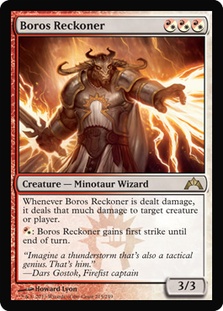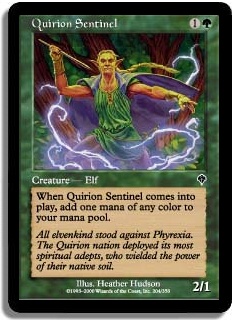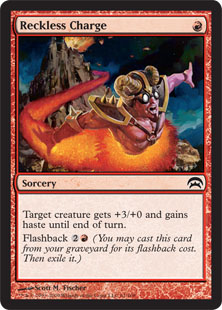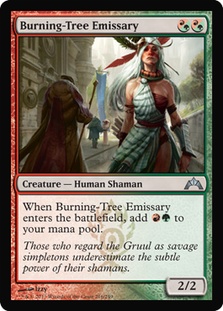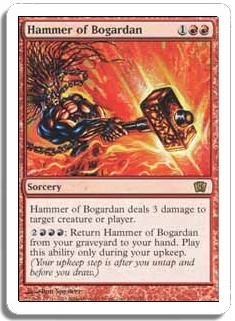Some men just want to watch the world burn.
Aggro decks aren’t my forte, but I do love attacking with some Savannah Lions. I won my first PTQ with a Boros Aggro deck in Extended right when Ravnica was released, and all that deck ever wanted to do was cast Isamaru, Hound of Konda until the opponent was dead and buried. I’ve always had a soft spot for aggressive decks with burn spells, and the current Standard format is no different. We have the tools at our disposal now that Gatecrash has been released. While the card that impressed me the most at first was Skullcrack, I think that Boros Reckoner has taken the cake.
Now, Boros Reckoner wasn’t a card that was even on my radar until Brad Nelson played it in one of our playtest videos. Not only does it laugh in Thragtusk’s face thanks to the first strike ability, but Boros Reckoner can’t even really be killed by an opposing red removal spell without absolutely wrecking the opponent’s board state. Of course, if they don’t have any creatures in play and decide to Searing Spear it, then fine. Just take three damage and let’s move on.
What about this Hellrider?
Of course, there are a lot of removal spells in Standard, but none of them are actually all that good. The best ones are red because they’re versatile, in that they can alternatively end the opponent’s life if they just so happen to be at a low enough number. Red removal spells have always been favored over others because of this versatility, though Standard is really showing us just how bad removal spells can be when every creature looks like Thragtusk.
While Thragtusk is the “best creature in Standard” or whatever you want to call it, it is inherently slow and doesn’t quite end the game on its own. That is one thing it took me a long time to wrap my head around, but I don’t necessarily know how I feel about it. Thragtusk isn’t Primeval Titan grabbing a pair of Valakut, the Molten Pinnacle (which should have been legendary anyway, but I digress). There are plenty of turns after Thragtusk resolves where you can interact and still very easily win, should you choose to do your best to ignore it.
Of course, the dreaded combination of Restoration Angel and Thragtusk is just game-ending to every aggressive deck that isn’t filled with hexproof creatures but can occasionally be game-ending against those decks too should they stumble. Ten life points and eleven power worth of creatures in just two cards is quite devastating.
As I’ve said before, Thragtusk is the pinnacle of interaction. If you decide to interact with it, you will lose. That is the way it was designed, and that’s just how it’s gotta be. We can do everything we can to ignore it by using Pyreheart Wolf, Thundermaw Hellkite, or just being much faster than them. This is occasionally hard to do thanks to the existence of Farseek and mana dorks like Arbor Elf and Avacyn’s Pilgrim, but the latter two can be killed very easily via Pillar of Flame and Searing Spear. If you push the limits on how fast you can become, you just might find that we have an incredibly powerful monster at our disposal.
What some of you may not know is that I began playing Magic with aggressive decks. Like most mages, I crafted decks out of every card of each color I owned. I had a red deck, a green deck, a black deck, and so forth. These decks were often over 100 cards and lacked a sufficient number of basic lands because they were pretty hard to find. When I started playing local tournaments, I began to realize these decks couldn’t compete. I learned quickly and eventually developed into a stable R/G Aggro player.
My love for aggression all began with one little combo:
While this particular combo isn’t that flashy, it did a lot of damage in a hurry. Reckless Charge wasn’t king of the castle, but it did see a reasonable amount of play. Even though Quirion Sentinel wasn’t broken, it was good, as it generated an early tempo advantage that could quickly overwhelm the opponent. Luckily, we get a functional reprint that is actively better.
Of course, Quirion Sentinel is not a creature many people remember now, mostly because it wasn’t in a lot of decks. Along with Reckless Charge, it could start you off with a helluva lot of damage as long as the opponent wasn’t throwing any blockers in your way. Along with cards like Fiery Temper and Wild Mongrel, we had a solid R/G Aggro deck that featured many of the same type of cards that are currently legal in Standard. For reference:
Creatures (20)
Lands (8)
Spells (32)
Sideboard

This isn’t the exact version I played back in the day, but it is pretty similar. Of course, now that the creatures are better, the deck has a bit more of a kick! Of course, the removal we have to play against is just about as good, but people are playing less of it because removal spells are actively bad against Thragtusk. We also have to fend off bigger threats than what we used to. There is the occasional all-powerful being that jumps through the multiverse that we have to tango with. Did you know that creatures used to die to removal without putting more creatures into play? Did you know that Hammer of Bogardan used to be a $15 rare as a reprint?
Times, they are a changin’.
Frog in a Blender was one of my favorite decks ever because it was one of the first really aggressive decks I played. It gave zero cares about what the opponent was trying to accomplish. All it wanted to do was kill every creature the opponent played, then attack them to death before they were able to execute their Desolation Angel or Dromar, the Banisher shenanigans. Usually, their life sputtered out in a flurry of Sonic Seizures and Fiery Tempers. Other times, Raging Goblin would actually do work.
A lot of you who are looking at that decklist didn’t realize that Raging Goblin was a card, in that it was a card that people actually played. Take a look at it. A 1/1 for R, has haste. That’s it. It doesn’t win the game on its own. It doesn’t kill a creature. It doesn’t get bigger every time it hits the opponent (although that would have been sweet). Raging Goblin doesn’t care about anything other than attacking and trying to deal the most damage it can to the opponent before they put up enough road blocks to nullify him completely.
There were versions that tried to “go a little bigger” by playing Call of the Herd and Arrogant Wurm, but those versions were much slower and gave the opponent enough time and breathing room to find answers. Both versions had their merits and were equally good at different points in the metagame, but it ultimately boiled down to whether or not your opponent could answer your threats fast enough. If they couldn’t, Raging Goblin it was. If they could, then maybe we have to be more resilient.
I tell you about this deck because I recently saw a deck posted by Saito on Twitter that looked remarkably similar, yet the creatures of today are so much more powerful than what we had back then. Of course, I’m sure I sound like an old timer, talking about decks we played twelve (gasp) years ago. Just writing that sentence makes me feel old.
But Frog in a Blender is something I would love to revive because, in its essence, it is pure aggression. It does everything it can to obliterate the opponent before they can get their feet off the ground. Burning-Tree Emissary gives you a much-needed tempo boost, allowing you to take complete control of the board in the early part of the game. The best part is that it also gives you a free source of mana fixing!
Red decks can’t afford to have their lands come into play tapped. This means Stomping Ground, Rootbound Crag, and Mountains are pretty much all you can play. Forests are out of the question thanks to Boros Reckoner, but Flinthoof Boar and Rancor just fit perfectly into the deck. Burning-Tree Emissary is the perfect solution on multiple fronts!
Creatures (28)
- 4 Stromkirk Noble
- 4 Hellrider
- 4 Flinthoof Boar
- 4 Ash Zealot
- 4 Rakdos Cackler
- 4 Burning-Tree Emissary
- 4 Boros Reckoner
Lands (8)
Spells (24)
Sideboard

Of course, 20 lands doesn’t really seem like a lot. That’s because it isn’t. One thing the deck can’t do is get mana flooded, but I’m not entirely sure that a few more lands would hurt that much. After all, you really, really, really want to cast Hellrider on turn 4 without any hiccups. Of course, your deck is full of gasoline that you can just keep pouring onto the fire if you don’t draw more than a few lands.
The early aggression of the deck can’t be matched by any other deck in the format. Your early threats are bigger, faster, and occasionally allow you to cast two more spells in the same turn. Burning-Tree Emissary not only acts as a way to boost tempo, but he also acts as easy mana-fixing for Rancor and Flinthoof Boar. If you’ve drawn a Flinthoof Boar or Rancor that you can’t cast due to Mountains being your only lands, Emissary can fix that and sometimes cast an additional spell! With such a low curve, I don’t think it will be uncommon for Emissary to regularly cast two spells, which should mean a lot!
While you can’t hybridize the mana given by Burning-Tree Emissary into all red in order to cast Ash Zealot or Boros Reckoner, you still get a reasonable body with a pretty huge upside if you have something to do with the mana. Whether that means just using Searing Spear to kill a creature so that your Stromkirk Noble gets to rumble on through or just casting another one-drop, the tempo boost will help you easily outclass a number of “reasonable” draws from your opponent.
Of course, you still have a little trouble beating cards like Thragtusk and Huntmaster of the Fells, as the massing of bodies onto the board as well as the incremental life gain can be problematic. If the opponent isn’t starting off the game with Farseek, you should be fine, but an early removal spell into Farseek into Thragtusk can just end the game on the spot.
Of course, that is unless you happen to draw a lot of Boros Reckoners. Boros Reckoner is an actual Magic card. I know that is hard to believe. It doesn’t die in combat very easily. It doesn’t die to red removal without causing some serious pain. It can trade with multiple creatures without much work. Boros Reckoner is one of the best additions that Gatecrash has to offer Standard, and I’m very much looking forward to putting a Rancor on it and bringing the beats.
In the past, cards like Rakdos Cackler have been pretty solid at what they do. They provide you with an early body to get some beats in while you kill their creatures and play more of your own. However, he does need some help. One of the reasons why I really liked the old B/G version of Zombies was because of Rancor, and I don’t think this deck is any exception. The fundamentals are the same, though the execution is a little different. The removal is better because it can go to the dome, and the suite of creatures in this deck is actually more aggressive than Dreg Mangler and Geralf’s Messenger.
Let that sink in for a moment…
While this Frog in a Blender / R/G Aggro or whatever you want to call it deck is fast, the real test will be to see if it can overcome its most hated enemy. Thragtusk will always be a problem for aggressive decks, if only because the life it gains buys the slower player more time to find an actual answer. This is especially true if you’re “playing fair” like most red-based aggressive decks. Your creatures don’t have hexproof, and you aren’t doing silly things like casting Spectral Flight, but you are blazing fast.
An ideal start:
Turn 1 Rakdos Cackler
Turn 2 Ash Zealot
Turn 3 Burning-Tree Emissary into Flinthoof Boar, give it haste
Now, that’s a lot of damage. Imagine if this is backed by a Hellrider on the fourth turn or just a few removal spells to get rid of any defenders the opponent might have thrown in play. Of course, this isn’t even a “nut” draw, as I’m sure that entails Rancor in some form or fashion.
While I’m not sure if this deck will overtake Standard, it will be what I’m playing this week in preparation for SCG Open Series: Edison. If it turns out to be as good as I think it is, then I just might be coming home with a trophy (or two)! Frog in a Blender…ah the memories. Playing with this deck just reminds me of when I started playing Magic in the first place. Nostalgia is a hell of a drug.
Be sure to catch the deck in action next week during our Vs. Videos, and I might just bring another catchy deck tech along with it.
Thanks for reading!
strong sad on Magic Online
@strong_sad on Twitter

